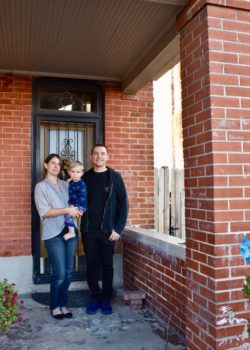News
DURA Helps Denver Family Living with Dangerous Lead-Based Paint Through New Grant Program
 When Stephanie and Justin moved to Denver three years ago, they immediately fell in love with a charming house in the heart of one of the city’s oldest and most historic neighborhoods. Built in 1890, the home needed significant work and had received few updates over the years. But Stephanie and Justin felt this only added to its character and were up to the challenge of renovating the home and making it their own. Together with their 5-year-old daughter, the young couple settled in, embracing the flaws that made the house unique.
When Stephanie and Justin moved to Denver three years ago, they immediately fell in love with a charming house in the heart of one of the city’s oldest and most historic neighborhoods. Built in 1890, the home needed significant work and had received few updates over the years. But Stephanie and Justin felt this only added to its character and were up to the challenge of renovating the home and making it their own. Together with their 5-year-old daughter, the young couple settled in, embracing the flaws that made the house unique.
Stephanie and Justin received a pamphlet about lead-based paint when they bought the home, but brushed it off, figuring it wasn’t something they needed to worry about. But the information lingered in the back of their minds. A few years later, Stephanie and Justin welcomed another baby to their family. With this new arrival, they decided to have the baby tested for lead by their pediatrician. To Stephanie and Justin’s shock, the test revealed elevated blood lead levels.
Lead-based poisoning has been identified as the No. 1 preventable environmental health threat to children in the United States. The primary causes of lead poisoning are ingestion of contaminated dust and soil found in or around older houses, and young children under the age of 6 are most at risk because of how quickly their brains grow and develop. Even low levels of lead can potentially cause permanent brain and nervous system damage, learning and behavioral problems, and result in lower IQ. There are often no visible signs or symptoms of lead poisoning. The Centers for Disease Control and Prevention estimates that more than 4 million American households nationwide have children exposed to high levels of lead.
“Nobody wants to involuntarily poison their child,” said Stephanie. “It was very stressful to say the least.”
As required by law, Stephanie’s pediatrician reported the lead test results to the Colorado Department of Public Health and Environment (CDPHE), who sent a health inspector to evaluate the family’s home.
The health inspector, Brendan, tested nearly every surface of Stephanie and Justin’s home and found it was riddled with high levels of lead. It wasn’t solely from paint chips, as most people assume – friction created by opening and closing doors and windows with lead paint caused dangerous lead dust to spread into the air. Lead dust was detected on windowsills, doors, walls, flooring, and was even being pumped into the air through the furnace.
Stephanie and Justin were horrified and overwhelmed, unsure of how to even begin addressing the problems.
The health inspector told Stephanie and Justin about a new grant program to help qualifying Denver families protect their children from lead hazards by offering lead-based paint mitigation and removal services at no cost.
The Lead-based Paint Hazard Control Grant Program is funded by the US Department of Housing and Urban Development (HUD) and is administered locally by the Denver Urban Renewal Authority (DURA) and Denver Department of Public Health and Environment (DDPHE). Through the program, qualifying homes receive a full lead-risk assessment, an abatement plan and abatement services. The program is free for homeowners and covers 100 percent of costs. The grant also includes funds to address 29 other healthy homes hazards such as fire alarms, pest control and mold mitigation.
Stephanie and Justin learned that they qualified for the grant program and were referred to DURA, who managed their project. DURA found a place for the family to stay temporarily while work was being performed, and brought in a qualified contractor to replace windows, doors and trim, seal woodwork and put on new doorknobs and locks.
“DURA was absolutely awesome. They fought for us to get the things we needed to keep our kids safe,” said Stephanie. “It’s a huge relief for them to come here and not just paint over things, but to actually properly mitigate it the right way.”
Lead-based paints were banned for use in housing in 1978. All houses built before 1978 are likely to contain some lead-based paint and should be evaluated if there are young children or expectant mothers living in the home. The Lead-based Paint Hazard Control Grant Program is designed to protect children ages 6 and younger from exposure to lead-based paint and other home health and safety hazards.
“I don’t even know what we would have done. If this program wasn’t available it’s very likely we would have had to sell the property. There’s no way we could have stayed here,” said Stephanie. “I’m looking forward to not having to worry anymore.”
To learn more about the Lead-based Paint Hazard Control Grant Program and see if your home qualifies, click here or call DURA at (303) 534-3872.